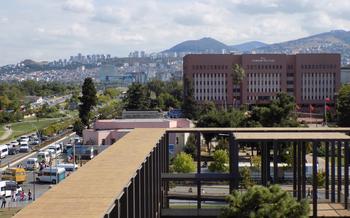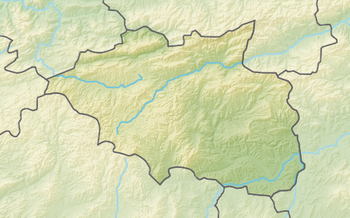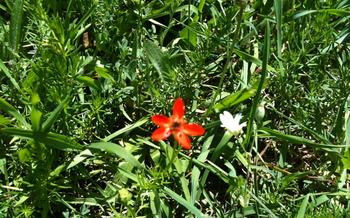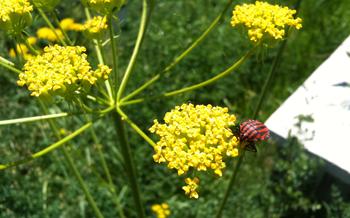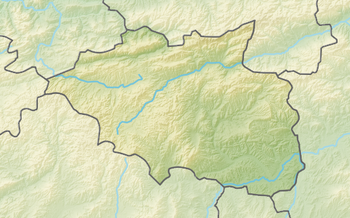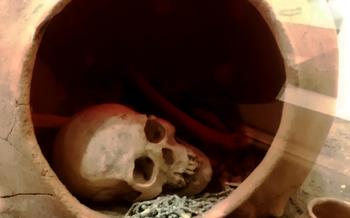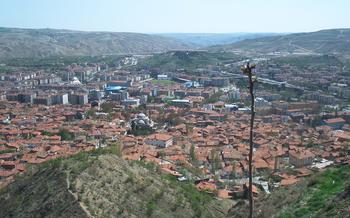
Korgun Hoyuk (Archaeological site)
- Unveiling Korgun Hoyuk: A Journey Through Time
- Location and Accessibility: Finding Your Way to Korgun Hoyuk
- What to Expect: Discovering the Layers of History
- A Walk Through the Ages: Exploring the Korgun Hoyuk Museum
- The Enigmatic Stele: Unraveling Ancient Mysteries
- Unveiling the Ancient City: A Glimpse into Urban Life
- The Royal Cemetery: Unveiling the Secrets of Power
- A Link to the Past: Exploring the Surrounding Area
- Planning Your Visit: Tips for a Rewarding Experience
- Guided Tours: Enhancing Your Understanding
- Documenting Your Journey: Capturing the Essence of Korgun Hoyuk
- Respecting the Site's Legacy: Preserving History for Future Generations
- Beyond the Dig: Exploring Turkish Cuisine and Culture
- Accommodation and Dining Options: Ensuring a Comfortable Stay
- Insider Tip: Unveiling Hidden Gems
Unveiling Korgun Hoyuk: A Journey Through Time
Korgun Hoyuk, an ancient settlement nestled in the heart of Turkey's Çankırı province, stands as a testament to the rich cultural tapestry of Anatolia. With its strategic location at the crossroads of civilizations, the site has witnessed the rise and fall of empires, leaving behind a treasure trove of archaeological wonders.
Excavations at Korgun Hoyuk have revealed a remarkable sequence of human occupation spanning several millennia. The earliest layers, dating back to the Chalcolithic period (4000-3000 BC), showcase the ingenuity of early farming communities. As time progressed, the site evolved into a thriving Bronze Age city, with evidence of sophisticated urban planning, metallurgy, and trade networks.
The preservation of Korgun Hoyuk is of paramount importance, not only for its archaeological significance but also for its role in bridging the gap between past and present. Ongoing excavations continue to unearth valuable insights into the lives and customs of our ancestors, enriching our understanding of Anatolian history and culture.
Location and Accessibility: Finding Your Way to Korgun Hoyuk
Korgun Hoyuk, a treasure trove of ancient history, is situated in the picturesque town of Korgun, within the Çankırı province of Turkey. To reach this captivating archaeological site, you can embark on a scenic journey that takes you through the heart of Anatolia's rich landscapes.
Getting There:
-
By Air: The closest airport to Korgun Hoyuk is the Çankırı Airport (CFT), located approximately 50 kilometers from the site. From there, you can take a taxi or rent a car to complete your journey.
-
By Road: Korgun Hoyuk is well-connected by road, making it accessible from various cities in Turkey. If driving from Ankara, the capital of Turkey, follow the D-100 highway towards Çankırı. From there, take the Korgun exit and continue on the provincial road to reach the site.
-
By Public Transportation: Regular bus services connect Çankırı to major cities like Ankara and Istanbul. From Çankırı, you can take a local bus or taxi to Korgun Hoyuk.
Proximity to Major Cities and Landmarks:
-
Ankara: Approximately 150 kilometers away, Ankara offers a gateway to Korgun Hoyuk for both domestic and international travelers.
-
Çankırı: Situated just 50 kilometers from the site, Çankırı serves as a convenient base for exploring Korgun Hoyuk and other regional attractions.
-
Cappadocia: A renowned region famous for its unique rock formations and hot air balloon rides, Cappadocia is approximately 200 kilometers from Korgun Hoyuk, making it an ideal add-on to your itinerary.
Insider Tip:
For a truly immersive experience, consider renting a car to explore the region at your own pace. This allows you to visit Korgun Hoyuk and other nearby archaeological sites, such as Gordion and Hattusa, while enjoying the flexibility of spontaneous detours and scenic stops along the way.
What to Expect: Discovering the Layers of History
As you delve into the depths of Korgun Hoyuk, a myriad of archaeological features awaits your discovery. Excavations have uncovered a treasure trove of artifacts, tools, and remnants of daily life, painting a vivid picture of the past. Ancient hearths, ovens, and storage pits provide glimpses into domestic activities, while workshops and kilns hint at the site's thriving craftsmanship.
Among the most intriguing finds are the remnants of diverse cultures and civilizations that have left their mark on Korgun Hoyuk. The site's strategic location facilitated trade and interaction with neighboring regions, resulting in a rich tapestry of influences. From pottery and jewelry bearing Anatolian motifs to tools and weapons reminiscent of the Hittite Empire, each artifact tells a story of cultural exchange and assimilation.
The excavation process itself is a testament to the meticulous work of archaeologists, who carefully unearth and document every find. Each layer of soil reveals new insights, offering clues to the site's chronology and the lives of its inhabitants. Whether it's a humble flint arrowhead or an exquisitely carved stone figurine, every artifact contributes to the rich narrative of Korgun Hoyuk's past.
A Walk Through the Ages: Exploring the Korgun Hoyuk Museum
The Korgun Hoyuk Museum is a treasure trove of artifacts and insights that bring the ancient city to life. Step into its halls and embark on a journey through time, where each display tells a story of the people who once called this land home.
The museum's collection boasts an array of artifacts, from intricate pottery and jewelry to tools and weapons that reveal the technological prowess of past civilizations. These items offer a glimpse into the daily lives of the inhabitants, their customs, and their beliefs.
Interactive exhibits and displays further enhance the experience, allowing visitors to engage with the history of Korgun Hoyuk in a hands-on manner. Through touchscreens and multimedia presentations, you can explore the city's layout, its architecture, and the lives of its people.
The significance of these artifacts lies in their ability to provide a tangible connection to the past. They serve as pieces of a puzzle, helping us understand the evolution of cultures and civilizations that shaped this region. By studying these remnants, researchers can piece together the story of Korgun Hoyuk and its place in the tapestry of human history.
The Enigmatic Stele: Unraveling Ancient Mysteries
Among the remarkable discoveries at Korgun Hoyuk is the enigmatic stele, a large stone slab inscribed with captivating symbols and characters. Unearthed during excavations, the stele has become a subject of intense scrutiny and debate among scholars and historians.
The language and symbols inscribed on the stele are unlike any known script, posing a significant challenge to decipher its meaning. While some experts believe it may be a form of proto-writing, others suggest it could represent a unique language or communication system used by the ancient inhabitants of Korgun Hoyuk.
The stele's inscriptions have sparked numerous theories and interpretations. Some scholars propose that it may be a religious text, containing prayers or invocations to deities. Others believe it could be a historical record, narrating events or achievements of the city's rulers.
The mystery surrounding the stele's meaning adds to its allure and significance. It represents a tantalizing glimpse into the minds and beliefs of an ancient civilization, inviting researchers to unravel its secrets and shed light on the rich cultural heritage of Korgun Hoyuk.
Unveiling the Ancient City: A Glimpse into Urban Life
As you delve deeper into the archaeological wonderland of Korgun Hoyuk, you will uncover the remnants of an ancient city that once bustled with life. Excavations have brought to light the foundations of homes, workshops, and public spaces, painting a vivid picture of the urban landscape that existed millennia ago.
Strolling through the excavated streets, you can almost feel the presence of the city's former inhabitants. Their footsteps have left an imprint on the cobblestones, and the walls still seem to whisper secrets of their daily lives. Imagine the hustle and bustle of the marketplace, the clanging of hammers in the workshops, and the lively conversations echoing through the squares.
The unearthed remains provide tantalizing clues about the city's economy and social structure. Storage facilities hint at a thriving trade network, while the presence of administrative buildings suggests a well-organized governance system. Discoveries of communal spaces, such as temples and gathering areas, speak to the importance of social and religious life in the community.
Each unearthed artifact, each revealed structure, adds a brushstroke to the canvas of history, bringing the ancient city back to life before your eyes. As you explore these remnants of a bygone era, you gain a profound appreciation for the ingenuity, resilience, and interconnectedness of human civilizations throughout the ages.
The Royal Cemetery: Unveiling the Secrets of Power
Beneath the ancient city of Korgun Hoyuk lies a hidden realm of power and prestige—the royal cemetery. Excavations have uncovered a series of elaborate tombs, each containing the remains of high-ranking individuals and their precious possessions. These burials offer a glimpse into the social hierarchy and funerary customs of the city's elite.
The tombs themselves are architectural marvels, constructed with meticulous care and adorned with intricate designs. Inside, archaeologists have discovered a wealth of grave goods, including jewelry, weapons, pottery, and other artifacts. These items provide valuable insights into the wealth and status of the deceased.
One of the most striking discoveries in the royal cemetery is the abundance of gold jewelry. The craftsmanship of these pieces is exquisite, featuring intricate filigree work and delicate gemstones. Gold was a symbol of power and prestige in ancient Anatolia, and its presence in the tombs suggests that the individuals buried here held positions of great authority.
The royal cemetery also sheds light on the funerary practices of the ancient city's inhabitants. The tombs were carefully constructed to ensure the deceased would have a comfortable afterlife. Grave goods were placed alongside the bodies to provide for their needs in the next world. These offerings included food, clothing, and even toys for children.
The exploration of the royal cemetery at Korgun Hoyuk has provided invaluable insights into the lives and beliefs of the city's elite. These tombs are a testament to the power and prestige of the ancient rulers who once governed this thriving city.
A Link to the Past: Exploring the Surrounding Area
Korgun Hoyuk is not only a treasure trove of ancient artifacts within its own borders but also serves as a gateway to a wealth of other historical and natural wonders in the surrounding region. A short distance away, the ancient city of Gordion, once the capital of the Phrygian kingdom, awaits exploration. Here, visitors can marvel at the impressive fortifications, remnants of temples, and the famous Gordion Knot, a legendary symbol of intricate complexity.
Venture further afield, and you'll discover the natural beauty of the Kızılcahamam district, renowned for its thermal springs and cascading waterfalls. Immerse yourself in the tranquil ambiance of these natural wonders, where you can unwind and rejuvenate amidst the picturesque landscapes.
For those seeking a deeper connection with the region's past, the Çankırı Museum offers a fascinating collection of artifacts and exhibits showcasing the rich cultural heritage of the area. Here, you'll gain insights into the diverse civilizations that have shaped this land, from the Hittites to the Romans and beyond.
These nearby attractions and points of interest provide an opportunity to delve further into the tapestry of Anatolian history and culture. Whether you're drawn to ancient ruins, natural wonders, or cultural experiences, the region surrounding Korgun Hoyuk promises a journey of discovery and wonder.
Planning Your Visit: Tips for a Rewarding Experience
To fully immerse yourself in the wonders of Korgun Hoyuk, planning your visit is essential. Aim to arrive during the spring or autumn months when the weather is pleasant, allowing you to explore comfortably. Dedicate at least half a day to comprehensively explore the site, including the museum, archaeological park, and surrounding areas.
Pack comfortable walking shoes, as you'll be traversing uneven terrain, and consider bringing a hat, sunglasses, and sunscreen to protect yourself from the sun. Remember your camera to capture the site's beauty, but be mindful of the photography guidelines to avoid disturbing the ongoing excavations.
To enhance your experience, consider hiring a local guide. Their expertise will provide valuable insights into the history, culture, and significance of Korgun Hoyuk, helping you make the most of your visit.
Guided Tours: Enhancing Your Understanding
Unveiling the secrets of Korgun Hoyuk is made all the more enriching with the guidance of experienced local experts. Guided tours are highly recommended to maximize your visit, as they provide invaluable insights into the site's history, culture, and significance.
Knowledgeable guides will lead you through the archaeological wonders, explaining the intricacies of the excavations and the stories behind the artifacts. They will point out hidden details and provide context to the discoveries, helping you to piece together the puzzle of this ancient civilization.
Guided tours are typically conducted in small groups, ensuring personalized attention and the opportunity to ask questions. They also offer a deeper understanding of the ongoing research and preservation efforts at Korgun Hoyuk, giving you a glimpse into the work of archaeologists and historians.
Whether you're a history buff, an archaeology enthusiast, or simply curious about the past, a guided tour will enhance your experience at Korgun Hoyuk and leave you with a lasting appreciation for this remarkable site.
Documenting Your Journey: Capturing the Essence of Korgun Hoyuk
As you explore the ancient wonders of Korgun Hoyuk, you'll undoubtedly want to capture the essence of your journey through photography and videography. While documenting your experiences, it's crucial to respect the site's preservation and avoid causing any damage.
Photography Guidelines:
-
Respect the Boundaries: Adhere to designated paths and avoid venturing into restricted areas to prevent disturbing the ongoing excavations and archaeological features.
-
No Flash Photography: Flash photography can damage delicate artifacts and harm the integrity of the site. Opt for natural light or low-light settings to capture the beauty of the ruins.
-
Tripods and Drones: The use of tripods and drones is generally not permitted to minimize interference with the archaeological work. Check with the site authorities for specific regulations.
-
Permission for Commercial Use: If you intend to use your photographs or videos for commercial purposes, such as publication or sale, be sure to obtain permission from the relevant authorities.
Sharing Your Discoveries:
-
Document Responsibly: While sharing your experiences on social media or travel blogs, be mindful of the site's significance and avoid revealing sensitive information that could compromise its preservation.
-
Promote Responsible Tourism: Use your platform to promote responsible tourism practices and encourage others to respect the site's heritage and contribute to its conservation.
-
Engage with the Community: Share your photographs and videos with local communities and organizations involved in preserving Korgun Hoyuk's legacy. Your contributions can help raise awareness and foster a sense of pride in the region's cultural heritage.
Respecting the Site's Legacy: Preserving History for Future Generations
As you explore the ancient wonders of Korgun Hoyuk, it is crucial to remember that you are treading on the remnants of a civilization that has long since passed. This archaeological site is not just a tourist attraction; it is a living testament to our shared human history. Therefore, it is imperative that we all play a role in preserving and protecting this precious heritage for future generations.
Responsible tourism practices are essential to ensuring that Korgun Hoyuk remains unharmed for years to come. Avoid touching or removing any artifacts or structures, as this can damage the site. Stay on designated pathways and refrain from climbing on walls or entering restricted areas. By respecting the integrity of the site, you are contributing to its long-term preservation.
Moreover, consider becoming a part of the ongoing research and conservation efforts at Korgun Hoyuk. Many organizations and institutions are actively involved in excavating, studying, and protecting the site. You can support their work through donations, volunteering, or simply by spreading awareness about the importance of this archaeological treasure.
Remember, we are all stewards of history. By respecting and preserving Korgun Hoyuk, we are ensuring that future generations can continue to marvel at its mysteries and learn from the civilizations that once thrived here.
Beyond the Dig: Exploring Turkish Cuisine and Culture
A trip to Korgun Hoyuk is not just a journey through time; it's also an opportunity to immerse yourself in the vibrant culture and cuisine of Turkey. The region boasts a rich culinary heritage, with dishes that blend traditional flavors with contemporary influences. From savory kebabs to delectable mezes, the local cuisine is sure to tantalize your taste buds. Don't miss the chance to try keşkek, a hearty dish made from pounded wheat, meat, and spices, which is a specialty of the region.
Beyond food, Turkey is renowned for its vibrant cultural traditions. Take the time to explore the local markets, where you can barter for handmade souvenirs and textiles. Engage with the friendly locals, who are always eager to share stories and insights into their way of life. Attend traditional festivals and events, where you can witness colorful performances, music, and dance. These cultural experiences will enrich your trip, providing a deeper understanding of Turkey's rich heritage and warm hospitality.
Accommodation and Dining Options: Ensuring a Comfortable Stay
When planning your visit to Korgun Hoyuk, finding suitable accommodation and dining options is crucial for a comfortable and enjoyable experience. While the immediate vicinity of the archaeological site may have limited options, several nearby towns and cities offer a range of choices to suit different budgets and preferences.
For a truly immersive experience, consider staying in one of the charming guesthouses or boutique hotels in the region. These accommodations often provide a glimpse into traditional Turkish architecture and hospitality, allowing you to connect with the local culture.
To savor the authentic flavors of Turkish cuisine, venture into the local restaurants and cafes. Indulge in mouthwatering kebabs, freshly baked pide bread, and delectable meze platters. Don't miss the opportunity to try keşkek, a local specialty made from wheat, meat, and spices, which holds a special place in Çankırı's culinary heritage.
Whether you prefer a cozy family-run establishment or a more upscale dining experience, you'll find plenty of options to satisfy your taste buds and make your trip to Korgun Hoyuk a truly memorable one.
Insider Tip: Unveiling Hidden Gems
Beyond the renowned Korgun Hoyuk, the surrounding region is a treasure trove of lesser-known archaeological sites, each offering a unique glimpse into the past. Embark on a journey to discover these hidden gems, where you can immerse yourself in the region's rich cultural heritage.
One such site is the ancient city of Paphlagonia, located a short drive from Korgun Hoyuk. Step back in time as you explore the ruins of this once-thriving city, marveling at the remnants of temples, theaters, and fortifications. Unearth the stories of the people who called Paphlagonia home, and gain insights into their daily lives and customs.
For a more off-the-beaten-path experience, venture to the Yazılıkaya Rock Reliefs, located in the heart of a picturesque valley. Here, you'll find an array of intricate rock carvings that depict scenes from ancient mythology and religious rituals. Marvel at the artistry and symbolism of these carvings, and let your imagination transport you back to a time when gods and goddesses roamed the land.
These hidden gems offer a unique perspective on the region's rich history and culture. As you explore these lesser-known sites, you'll gain a deeper appreciation for the diversity and complexity of Turkey's archaeological heritage. So, venture beyond the familiar and discover the hidden wonders that await you in the vicinity of Korgun Hoyuk.
